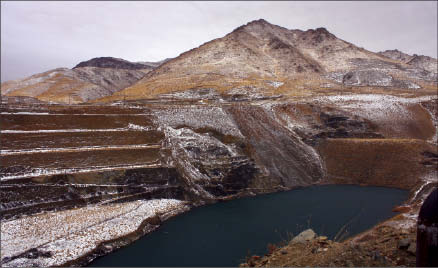Atna Resources (ATN-T) plans to start commercial underground mine production in this year’s fourth quarter at its Pinson gold project near Winnemucca, Nev., and is exploring the possibility of developing an open-pit mine on the property based on a maiden open-pit resource estimate.
Atna released its first open-pit resource estimate on Feb. 6 and says it will undertake a feasibility study while the company ramps up towards underground production.
Measured and indicated resources for an open pit at Pinson stand at 23.1 million tonnes grading 1.32 grams gold per tonne for 981,700 contained oz. gold, while inferred resources add 747,900 tonnes at 1.18 grams gold for 28,300 contained oz. gold.
Pinson’s underground resource stands at 2.65 million tonnes grading 12.60 grams gold for 1.07 million contained oz. gold in the measured and indicated category, plus 2.03 million inferred tonnes of 12.97 grams gold for 845,900 contained oz. gold.
Combined measured and indicated resource estimates for the high-grade underground zones were largely unchanged from prior estimates in 2007, but inferred resources were slightly lower, the company says, in part because of more conservative interpolation parameters based on a larger data set, additional data that changed geological interpretations in local areas and interaction with estimated open-pit resources.
Atna’s contract miner at Pinson is driving a secondary access, and the company believes it can begin mining bulk metallurgical samples in the next quarter.
The Pinson mine is in the south-central portion of the Getchell gold belt southwest of Barrick Gold’s (ABX-T, ABX-N) Getchell and Turquoise Ridge mines, and Newmont Mining’s (NMC-T, NEM-N) Twin Creeks mine complex.
Gold mineralization at Pinson is characterized as a Carlin-type, sediment-hosted gold system. Atna believes Pinson is hosted by the same sequence of Ordovician sedimentary rocks that hosts the gold deposits of Twin Creeks and Turquoise Ridge mines, according to its website.
Pinson is permitted for underground mining under a small miner’s permit, but Atna plans to amend the permit and allow full-scale underground operations.
The ore from Pinson will be sent to nearby third-party plants for processing. Barrick and Atna have a non-exclusive agreement that allows Atna to process Pinson ore at Barrick’s Goldstrike facilities 193 km to the east.
If the company develops an open-pit mine at Pinson permitting would be required, which could include an environmental impact study.
Pinson produced 985,000 oz. gold through open-pit mining and heap leach and oxide mill recovery between 1980 and 1999. Since 1998 the mine has seen more than US$60 million in exploration and development spending. Until now, resource estimates for Pinson’s remaining open-pit potential had never been completed.
Atna consolidated the entire Pinson mine in August 2011 by picking up Barrick Gold’s 70% interest through Barrick’s subsidiary, Pinson Mining. Barrick retained a 10% net profit royalty through Pinson Mining after producing the first 120,000 oz. gold, and is Atna’s largest shareholder with 12.8% of its outstanding stock.
Wendell Zerb, a mining analyst at Canaccord Genuity in Vancouver, initiated coverage of the company on Feb. 12 with a “speculative buy” rating and a target price of $3.20 per share.
At presstime Atna traded at $1.02 per share within a 52-week range of 52¢–$1.15. The junior has 117.3 million shares outstanding.
“We believe that Pinson — which has the potential to produce 50,000 to 100,000 ounces of gold per year, at US$750 to US$850 per ounce — cash costs [before royalties] could transform Atna into a significant junior gold producer, driving a revaluation of the company’s stock,” Zerb writes. “Despite above-average production costs, third-party processing of ore means that no plant capital expenditure is required, favourably impacting free cash flow.”
Last year Atna produced 33,018 oz. gold from its fully owned Briggs project, a conventional open-pit, heap-leach operation in Inyo County, Calif. Zerb believes production at the Briggs mine could reach over 50,000 oz. gold by 2013, at cash costs below US$750 per oz. gold.
“We believe Atna has the potential to expand its gold production from 35,000 ounces per year to over 150,000 ounces per year by 2014, based largely on its ability to fast track the Pinson gold project into production,” Zerb writes, adding that he believes Atna’s shares are significantly undervalued.
“On a price to net asset value five-percent basis, Atna trades at a steep discount to small-cap gold producers tracked by Canaccord,” the analyst argues.
“Atna is currently trading at a net asset value five-percent price [US$1.75 per oz. gold peak pricing] of 0.19 times versus small- to mid-cap producers in our universe that trade at an average net asset value five-percent price [US$1,750 per oz. gold peak pricing] of 0.70 times. On an in-situ basis, Atna’s 5.6-million, equivalent-ounce gold mineral resource is being valued at US$21 per ounce gold equivalent, versus our in-situ gold database average of US$104 per ounce.”


Be the first to comment on "Atna’s Pinson project has open-pit potential"